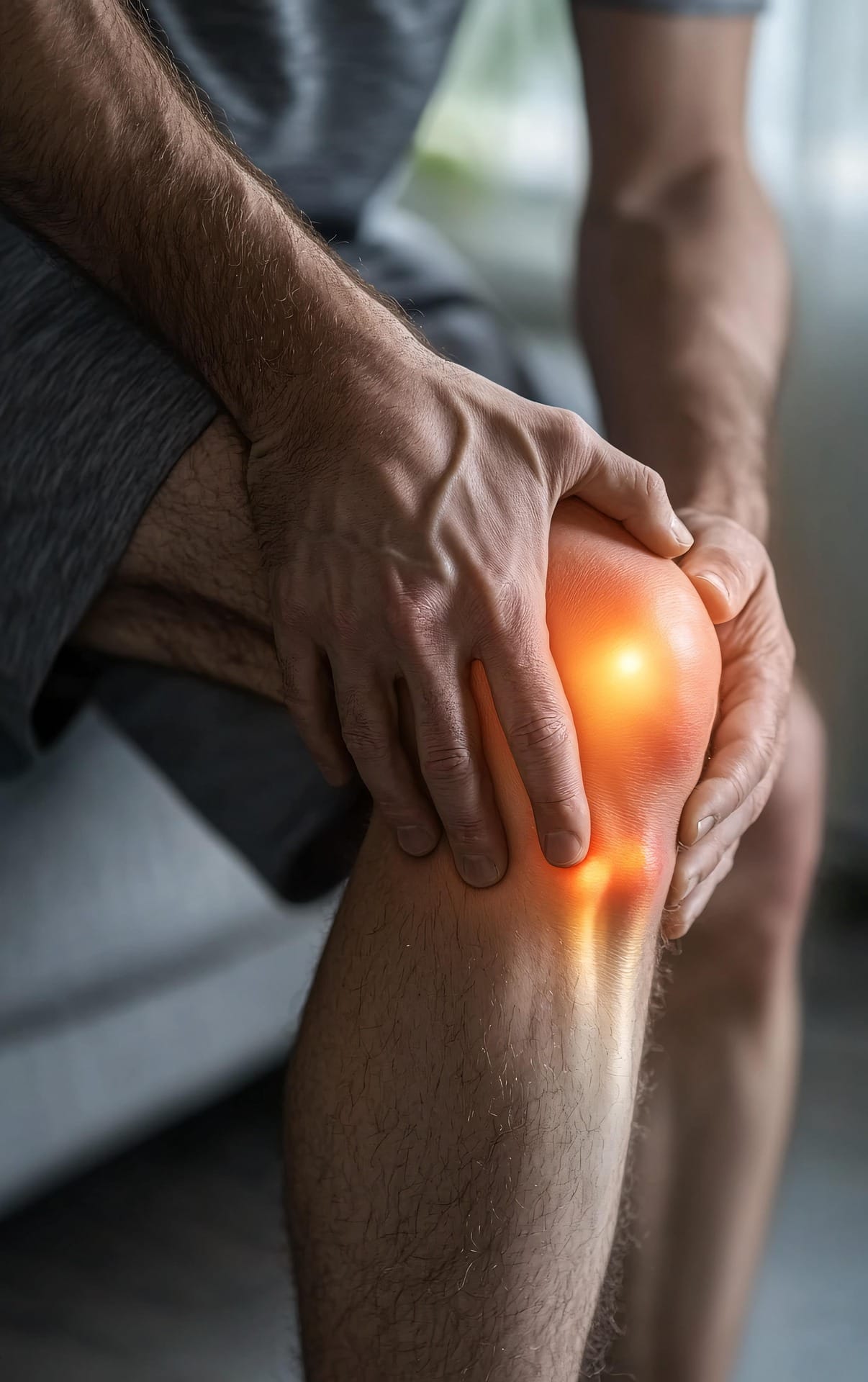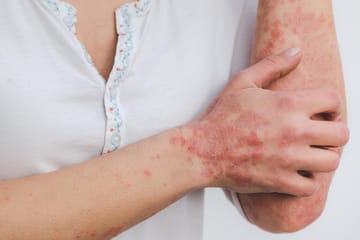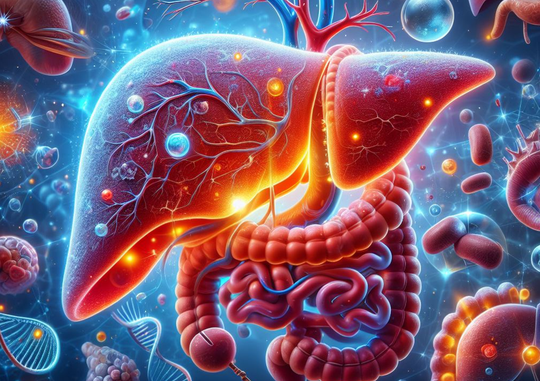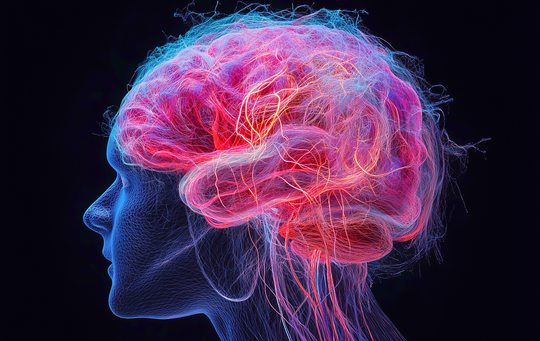Almost everyone has had tendonitis in the past. "Tendonitis" means inflammation of the tendon. That inflammation commonly occurs in tendons across the body, such as the biceps tendon in your arm, a Golfer or Tennis elbow, a Jumper's knee, your Achilles tendon, or the rotator cuffs in the shoulder.
(Tendons attach the muscle to your bone)
Especially if you're young and involved in sports, it's likely that that sore knee or shoulder had a tendon involved. Generally, joint problems occur when you're older but tendon problems already affect the young - such as because of overwork!
I've been there myself, both as an athlete and as a physical therapist seeing patients with these issues!
So today, I explore red light therapy for tendonitis (tendon injury and inflammation). I've added a summary below explaining the basics to you, but if you want the full details, keep scrolling below:
So tendonitis is a form of tendinopathy - a tendon condition. With tendonitis, you've often got an acute injury and there's always inflammation involved. Over time, the inflammation can go away and you'll end up with a tendinopathy - a chronic tendon problem.
Tendons, when affected, can be painful - especially during movement - and have reduced function, leading to movement problems. Once you have a tendinopathy, there are different physical alterations, such as the nerves, collagen disorganization, and more. So, you'll want to avoid both tendonitis and tendinopathy.
Tendonitis is commonly treated with rest, ice, compression, and elevation (RICE), though inflammation may aid healing, so this process may be counterproductive. Recent science shows that exercise therapy, especially eccentric exercise (where you lengthen a muscle), shockwave therapy, and platelet-rich plasma (PRP) injections, and fixing your diet and supplementation (collagen!) aid tendon recovery. Fortunately, red light therapy can also be added to that list.
Red light therapy has a decent evidence base for tendinopathy, with animal studies leading. Human studies generally show benefit with doses of 2 - 20 J/cm2 per day and an emphasis on near-infrared light. For the best results you'll have to treat your tendon several times per week. More research is needed here, however, with the testing of different treatment parameters and devices. For the best results, combine exercise, lifestyle adjustments, physical therapy, and red light therapy. At the end of this article, I also give more context on device recommendations!
If you need an introduction to what these terms mean, check the following resources:
- What Is Red Light Therapy?
- Red Light Therapy Explained: Basic Terms Guide
- Start Here - Light Therapy 101 & Buyers Guide
- Red Light Therapy Dosing Chart: The Raw Data From Hundreds Of Studies
- Red Light Therapy Dosing: Why It's Complicated!
- Red Light Therapy Wavelengths Benefits: The Ultimate Guide
- How Often Should You Use Red Light Therapy Explained
These resources should give you a basic understanding of how red light therapy works, and the discussions around it!
However, the picture at the beginning of this article is AI-generated, though!
Tendonitis And Tendinopathy Basics
So let's explore the latest science on tendonitis. I've checked the most recent medical reviews on this topic, which have analyzed and integrated high-quality evidence. These mostly concern reviews regarding "tendinopathy", which is a broader term for "tendon injury" (1; 2; 3; 4; 5; 6; 7; 8; 9; 10).
Here's what happens with a tendinopathy, biologically, according to a recent review on the topic:
"The prominent histological and molecular features of tendinopathy include disorganization of collagen fibres, an increase in the microvasculature and sensory nerve innervation, dysregulated extracellular matrix homeostasis, increased immune cells and inflammatory mediators, and enhanced cellular apoptosis. Although diagnosis is mostly achieved based on clinical symptoms, in some cases, additional pain-provoking tests and imaging might be necessary. Management consists of different exercise and loading programmes, therapeutic modalities and surgical interventions; however, their effectiveness remains ambiguous." (1)
So there's clear damage with a tendinopathy, with different blood flow, and alterations in the nerves and immune systems. Inflammatory processes aslo change.
So, what's the link between a tendinopathy and tendonitis? The former definition is often used for a more chronic tendon condition that's not necessarily paired with excess inflammation. With tendonitis, there's inflammation present. Tendonitis is also more acute in its character.
With tendonitis, the acute inflammation may be paired with redness, swelling, pain, and even warmth. Wit a tendinopathy, only pain may be present, as well as poor function.
Once a tendinopathy becomes chronic, the tendon itself and adjacent structures, such as the muscles, may degenerate and become less functionally capable. The collagen formation around the tendon changes and it may thicken (but with poor structure). Many cases of "tendonitis" are actually a tendinopathy because inflammation isn't always present!
The main cause of tendonitis is repetitive strain, overactivity, or improper movement. So, either overdoing things or moving poorly can trigger this condition. An example of the latter is having poor technique in the gym, leading to knee, shoulder, or elbow injuries! With tendonitis, the pain is generally worst during movement and may deteriorate if you burden the joint and tendon excessively
Tendonitis risk factors also include aging, poor posture, and poor recovery in general. Normally, the recommendation for tendonitis is RICE - "Rest", "Ice", "Compression", and "Elevation" - although this tendency may be questioned as the intial inflammatory response, for instance, may not be the best course of action. Some (pain-free or mostly pain-free) movement and no ice are likely better in my opinion
I've seen many tendonitis cases as a physical therapist!
If the situation deteriorates, patients often seek out physical therapists. Patients may also use corticosteroid injections to dim the pain (although, I'm not a fan as these injections may lower tendon strength long-term!) and even surgery as a last-case option! If you leave the tendon untreated, there may be chronic tendon damage, and you're entering the more chronic "tendinopathy" territory!
To prevent tendonitis, ensure you're using proper warm-ups, strengthening exercises, ergonomic adjustments, and avoiding overuse of the tendon! Maintaining good posture and varying movements can also reduce overall strain.
This advice is more common sense, however. Science has somewhat of a problem completely understanding tendon injuries despite them seeming so simple! Here's what a very comprehensive review states about treating tendinopathy:
"Eccentric exercises were the most common and consistently effective treatment for tendinopathy across systematic reviews. [Red light therapy] and extracorporeal shockwave therapy demonstrated moderate effectiveness, while platelet-rich plasma injections demonstrated inconclusive evidence on their ability to decrease tendinopathy-related pain and improve function. Corticosteroids also showed some effectiveness for short-term pain, but for the long-term use deemed ineffective and at times contraindicated. Regarding surgical options, minimally invasive procedures were more effective compared to open surgical interventions. When treating tendinopathy regardless of location, eccentric exercises were the best treatment option to improve tendinopathy-related pain and improve self-reported function." (2)
Eccentric exercises lengthen the muscle, often toward the gravitational pull. So squatting down into a chair is an eccentric movement, and standing up is a concentric movement for the thigh muscles at the front of your legs. Interestingly, red light therapy is effective, as described above - a topic we'll explore in more detail soon!
Another overarching review of earlier reviews finds that physical therapy is also a good intervention (3). Physical therapy leads to less pain and quite a lot better function overall.
And, not only does eccentric exercise work better - greater intensities (as a % of your max lifts) also work well (4). Be careful with that strategy, however, and warm up properly. And monitor your symptoms over time while slowly building up your exposure! Combining exercise with other conservative modalities such as red light therapy likely improves results even more (5). Dry needling is another example (9)
Different types of tendinopathy may need different treatments, but it's best to consult your physical therapist for that (7). As always, your diet and supplements - and broader lifestyle also play a role. Here's a review on the role of supplements in tendinopathy:
"Despite a paucity of studies to date, findings from this review suggest that several nutritional compounds may be beneficial in the clinical management of tendinopathies, by exerting anti-inflammatory effects and improving tendon healing. Nutritional supplements may have potential as an adjunctive method to standard treatment methods such as exercise, where their pain-relieving, anti-inflammatory, and structural tendon effects may augment the positive functional outcomes gained from progressive exercise rehabilitation." (8)
Instead of recommending specific supplements here, my suggestion here is to use common-sense advice. Eat a healthy diet that works for you and supplement where necessary. Supplements made out of gelatin, collagen, and bone broth may be the exception here and work specifically in the case of tendinopathy (8; 10).
So, let's now explore what red light therapy can do for tendinopathy:
How Red Light Therapy Can Help Ease Tendonitis
Fortunately, there's lots and lots of research on red light therapy for tendonitis - or tendinopathy in general! Vladimir Heiskanen has categorized about 70 studies on red light therapy for tendons right now (11).
I'll only focus on reviews here, as this article is short. In the future, I could update this article with more details if readers are interested. For now, let's consider the basics:
Red Light Therapy For Achilles Tendonitis
There are tons of studies on red light therapy for Achilles tendonitis - I count 70 in total, but most of them are animal studies (11). There are three recent reviews on red light therapy for Achilles tendinopathy (12; 13; 14).
Here's the outcome of the first review, which investigates only human studies:
"Four trials (119 participants) were analyzed. Laser therapy associated to eccentric exercises when compared to eccentric exercises and sham had very low to low certainty of evidence in pain and function assessment. Despite one trial favored laser therapy at two months (mean difference (MD) -2.55, 95% confidence interval (95% CI) -3.87 to -1.23), the CIs did not include important differences between groups at 3 and 13 months. The function assessment showed an improvement favoring the placebo group at one month (MD 9.19, 95% CI -16.16 to -2.23) and non-significant difference between groups at 3 and 13 months. Adverse events were poorly reported but restricted to minor events related to the exercises." (12).
Basically, there's no benefit here for pain but some for functional ability (such as movement) for treatment in the first two months. However, overall, the study quality is low and there isn't sufficient evidence to recommend light therapy for Achilles treatment here.
The criteria for recommending the universal application of light therapy are rigorous here, however! To achieve that rigorous standard, you'd need multiple high-quality RCT studies (with a placebo and intervention group) with lots of participants and the same treatment protocol - which is hard to reach.
Secondly, a rat study review used 33 earlier animal studies. Here's the outcome of that review:
"Light parameters identified per point of irradiation were approximately 60 mW (continuous mode at infrared spectra), 2 W cm2 , 2 J and 45 J cm2 . Light parameters at red spectra, continuous versus pulsed mode, and PBMT combined or compared with other therapies such as ultrasound, and studies using unhealthy rats (ovariectomized and/or diabetic models) were also identified and grouped according to these similarities. The main effects found were decreased inflammatory markers and signs of inflammatory process. PBMT (laser/LED) has positive effects in reducing the inflammatory and time for tissue repair in animal models of tendon injury and/or tendinitis using parameters identified."(13)
So that's a decent outcome! You also know the dosing protocol of up to 45 J/cm here. Here, there is a benefit for inflammation, very explicitly, which is the main issue with tendonitis. Tissue repair also seems to be increased.
Thirdly, another review study of rats' Achilles tendons found similar outcomes (14). Researchers write:
"Regarding the main results found with phototherapy, we observed a significant reduction in inflammation. Only one article mentioned little reduction of inflammation. In relation to the number of sessions, there was wide variation, with an average of approximately 5 sessions every 24 hours. Studies in this review pointed out, therefore, positive results in the repair of the calcaneal tendon after therapy with irradiation LED; however, carrying out more experimental studies that help the standardization of parameters to be used in this therapy for further clinical studies becomes necessary." (14).
Here's my overall viewpoint on the topic:
Red Light Therapy For Tennis Elbow
Here, there's not too much research, with three reviews published throughout the years (15; 16; 17). Here's the outcome of the first review:
"This umbrella review found poor results for the effectiveness of [red light therapy]in the management of [tennis elbow]. Therefore, further research with well-designed RCTs is required to provide meaningful evidence on the effectiveness (absolute and relative) of [red light therapy] for the management of [tennis elbow]." (15).
Secondly, another review had the following outcome:
"Differences between treatment and control groups were larger than differences between treatments. Control group gains were 50 to 66% as high as treatment group gains. Still, only treatment groups with their combination of therapy specific and non-therapy specific factors reliably met criteria for clinical relevance." (16).
Thirdly, the last review shows a slight benefit of light therapy versus other treatments:
"Injection of botulinum toxin A and prolotherapy are superior to placebo but not to corticosteroids, and botulinum toxin A is likely to produce concomitant extensor weakness. Platelet-rich plasma or autologous blood injections have been found to be both more and less effective than corticosteroid injections. Non-invasive treatment methods such as bracing, physical therapy, and extracorporeal shockwave therapy do not appear to provide definitive benefit regarding pain relief. Some studies of low-level laser therapy show superiority to placebo whereas others do not." (17).
So, platelet-rich plasma and light therapy may have the highest efficacy here!
The treatment parameters? For the tennis elbow, mostly near-infrared wavelength such as 820, 904, and 1,060 nm are used (18). After a few months, treatment outside the acute phase also seems to yield the best results (19).
General Reviews On Light Therapy For Tendonitis
Lastly, there are a few reviews on red light therapy for tendinopathy in general. I'll go over these one by one - but these don't pertain to any tendon problem in general but may include the knee tendon on your patella, or the shoulder tendon of the supraspinatus muscle, etc!
Here's what the first review writes:
"The most common wavelengths used were 660, 830, and 904 nm with energy density range between 1 and 17 J/cm2 and applied mostly daily. Fourteen studies (64%) relied merely on a single assessment. Histological measurements were the most common method of evaluation (75%) and 35% of studies used chemical measures. Mechanical outcomes were reported in four, and two studies demonstrate significant effects. [Red light therapy]has the potential to enhance tendon structure and function, however, inevitable embedded heterogeneity related to study design and quality of methods, light parameters delivered, and evaluations methods renders the ability to establish unified treatment parameters difficult." (20)
So that's clear! But, there are a few flaws that researchers have stated, such as that many different studies use different treatment parameters. And we're lacking high-quality human studies right now in this case. So it's not possible to recommend one set of treatment parameters as the best, over and above others!
The second review concludes with the following, moreover:
"There is very-low-to-moderate quality evidence demonstrating that [red light therapy] has utility as a standalone and/or adjunctive therapy for tendinopathy disorders." (21)
And, while the full picture may be more complicated, here too you'll find additional benefit by using red light therapy for tendinopathy! The third review, lastly, also finds benefits to red light therapy, even in the short term (22). So a benefit that may not exist for tennis elbow may be applicable to other tendons across the body!
Fourthly, here's a great review that explains the role of red light therapy for tendon injuries in different phases:
" In the inflammatory phase, LLLT mainly activates a large number of VEGF and promotes angiogenesis under hypoxia. During the proliferation phase, LLLT increases the amount of collagen type III by promoting the proliferation of fibroblasts. Throughout the remodeling phase, LLLT mainly activates M2 macrophages and downregulates inflammatory factors, thus reducing inflammatory responses. However, it should also be noted that in the final phase of tendon repair, the use of LLLT causes excessive upregulation of some growth factors, which will lead to tendon fibrosis." (23)
So paradoxically, you'll want to use red light therapy early on in a tendon injury. Later on, you may want to be careful about overdoing red light therapy because of the risk of tendon fibrosis. With a single study reporting the fibrosis, however, it's not my main worry, but technically you should be careful if you want to avoid all risk.
Lastly, one more review concludes the following:
"[Red light therapy] facilitates tendon healing through various histological, physiological, and biomechanical effects in animal models. Only post-[red light therapy] anti-inflammatory effects were found in human studies." (24)
Again, it was a decent outcome! Hence:
So, Is Red Light Therapy Worth A Try?
Even though the evidence isn't rock solid, and we need more studies on this topic, there's preliminary evidence in both human and animal studies that it works for different goals. Whether you're talking about red light therapy for achilles tendonitis, or red light therapy for patellar tendonitis, or red light therapy for elbow tendonitis, it's certainly worth a try!
Follow the treatment guidelines I've posted below for the best results - that are currently scientifically validated. Over time, however, it may turn out that other wavelengths work better for tendonitis.
There are also exceptions, such as red light therapy for torn ligaments. Here, a partially torn ligament may heal and benefit from light therapy but with a complete tear, it's different. Complete tears often need surgical intevention for healing - which is a more complex situation, whereby PRP which I've talked about above may also be very helpful!
Overall I also recommend combining red light therapy with other modalities, such as physical therapy or eccentric movement. The combinations of these therapies often have the best results! If your diet and lifestyle aren't on par, you may also want to focus on these.
Other Research And Anecdotes
We've got a wonderful red light therapy Facebook group where you can read loads of stories of participants who have used red light therapy for tendonitis:

You can join that group below:
In that group, you can search for "tendon" - I already got dozens of responses for that search term! There, you can not only learn from other participants' experiences in that group but also ask questions about treatment protocols and interact with other red light therapy users!
Join us and find out!
Best Devices For Tendonitis
So, what are the best red light therapy devices for tendonitis? First up, I'll keep things simple and focus on a device that has been specifically created for this goal - the Kineon MOVE+ Pro:
That device can be wrappend around any joint, such as the knee (where it was originally made for!), the shoulder, hip, or elbow, as there are straps included. And, you then get a specific treatment that's optimal for the joint. For tendons, of course, you'll need to slightly adjust the strap so that it targets the tendon that's affected for you.
Another option here are handheld red light therapy devices - these are big enough by far for local treatment and overlap any tendon in the human body, plus the nearby area:
Easy peasy!
Next, you may consider one of the other red light therapy travel devices. Often, these devices are great for treating smaller areas of the body, such as tendons:
Most of these travel devices will work, except for specialized devices such as masks listed above.
However, you may want to get a bigger panel because of its ability to treat larger areas of the body. Bigger panels aren't needed to treat tendons per se but are great for general health. You may want to watch my friend Alex Fergus' - the founder of this website - comparison videos of different sizes of panels:
Conclusion - Does Red Light Therapy Work For Tendonitis? Likely, Yes!
The future for tendonitis is likely bright! I remember having many physical therapy clients who had problems with a golfer's elbow or tennis elbow for months or even years!
And yet, with red light therapy, we've finally got a tool to move the needle. What's even better is that there's scientific evidence right now for other interventions, such as exercise therapy, physical therapy, upgrading your nutrition and supplements (collagen!), and more. And you don't have to pick one strategy here - you can stack multiple ones to get better results!
With the tool of red light therapy, hopefully, the months and years of pain and poor function that many people go through will be severely limited. Yes, we need more human studies on this topic to better examine the best wavelengths, devices, treatment frequency, and so forth, but current evidence is already promising!
So, try it. You'll like it!
This is a post by Bart Wolbers. Bart finished degrees in Physical Therapy (B), Philosophy (BA and MA), Philosophy of Science and Technology (MS - with distinction), and Clinical Health Science (MS), has had training in functional medicine, and is currently chief science writer at Lighttherapyinsiders.com
Found This Interesting? Then You Might Like:
- Red Light Therapy for Arthritis: The Complete Guide
- Start Here - Light Therapy 101 & Buyers Guide
- Discount Codes, Deals & Recommendations - Red Light Therapy
- 12 Exciting THOR Photomedicine Studies Explained
- Kineon Move+ Pro Review: Targeted Red Light For Joints?
- How To Use Red Light Therapy 101: The Best Guide For Starters
- Red Light Therapy For Knee: Devices And Practical Tips









